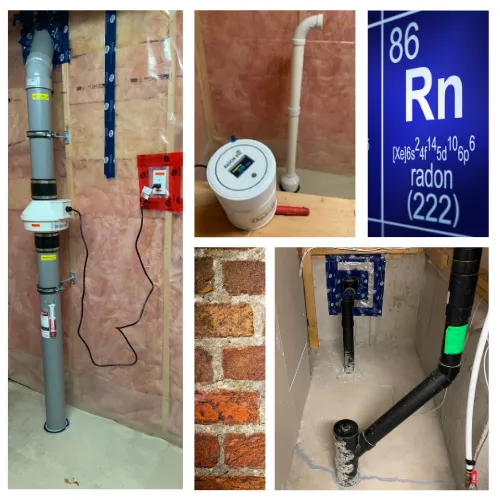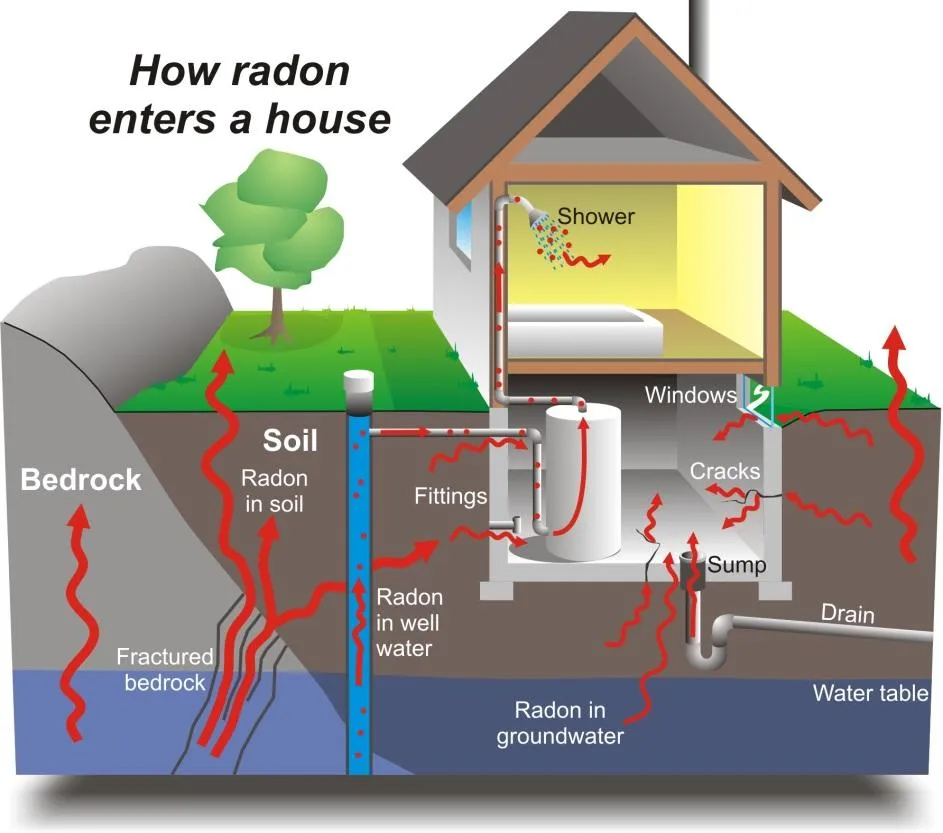Radon(Rn) Testing Information
Radon is a carcinogenic gas that is hazardous to inhale. Build-up of radon in homes is a health concern and many lung cancer cases are attributed to radon exposure each year. About 12% of lung cancers and more than 20,000 Americans die of radon-related lung cancer each year. The Surgeon General of the United States has issued a Health Advisory warning Americans about the health risk from exposure to radon in indoor air. Dr. Carmona, the Nation’s Chief Physician urged Americans to test their homes to find out how much radon they might be breathing. He also stressed the need to remedy the problem as soon as possible.
You cannot see, smell, or taste radon. But it still may be a problem in your home. When you breathe air containing radon, you increase your risk of getting lung cancer. In fact, the Surgeon General of the United States has warned that radon is the second leading cause of lung cancer in the United States today.
If you smoke and your home has high radon levels, your risk of lung cancer is especially high.

Testing is the only way to find out your home’s radon levels.
EPA and the Surgeon General recommend testing all homes below the third floor for radon. If you find that you have high radon levels, there are ways to fix a radon problem. Even very high levels can be reduced to acceptable levels. Radon has been found in homes all over the United States. It comes from the natural breakdown of uranium in soil, rock and water and gets into the air you breathe. Radon typically moves up through the ground to the air above and into your home through cracks and other holes in the foundation. Radon can also enter your home through well water. Your home can trap radon inside.

Any home can have a radon problem. This means new and old homes, well-sealed and drafty homes, and homes with or without basements. In fact, you and your family are most likely to get your greatest radiation exposure at home. That is where you spend most of your time. Nearly 1 out of every 15 homes in the United States is estimated to have an elevated radon level. Elevated levels of radon gas have been found in homes in your state.
EPA’s Radon Testing Check List:
Notify the occupants of the importance of proper testing conditions. Give the occupants written instructions or a copy of this Guide and explain the directions carefully.
Conduct the radon test for a minimum of 48 hours; some test devices have a minimum exposure time greater than 48 hours.
When doing a short-term test ranging from 2-4 days, it is important to maintain closed-house conditions for at least 12 hours before the beginning of the test and during the entire test period.
When doing a short-term test ranging from 4-7 days, EPA recommends that closed-house conditions be maintained.
If you hire someone to do the test, hire only a qualified individual.
Some states issue photo identification (ID) cards; ask to see it.
The tester’s ID number, if available, should be included or noted in the test report.
The test should include method(s) to prevent or detect interference with testing conditions or with the testing device itself.
If the house has an active radon-reduction system, make sure the vent fan is operating properly. If the fan is not operating properly, have it (or ask to have it) repaired and then test.
If your home has not yet been tested for Radon have a test taken as soon as possible. If you can, test your home before putting it on the market. You should test in the lowest level of the home which is suitable for occupancy. This means testing in the lowest level that you currently live in or a lower level not currently used, but which a buyer could use for living space without renovations.
The radon test result is important information about your home’s radon level. Some states require radon measurement testers to follow a specific testing protocol. If you do the test yourself, you should carefully follow the testing protocol for your area or EPA’s Radon Testing Checklist. If you hire a contractor to test your residence, protect yourself by hiring a qualified individual or company.
Many states require radon professionals to be licensed, certified, or registered. Most states can provide you with a list of knowledgeable radon service providers doing business in the state. In states that don’t regulate radon services, ask the contractor if they hold a professional proficiency or certification credential. Such programs usually provide members with a photo-ID card, which indicates their qualification(s) and its expiration date. If in doubt, you should check with their credentialing organization. Alternatively, ask the contractor if they’ve successfully completed formal training appropriate for testing or mitigation, e.g., a course in radon measurement or radon mitigation.
If you are thinking of selling your home and you have already tested your home for radon, review the Radon Testing Checklist
to make sure that the test was done correctly. If so, provide your test results to the buyer.
No matter what kind of test you took, a potential buyer may ask for a new test especially if:
The Radon Testing Checklist items were not met;
The last test is not recent, e.g., within two years;
You have renovated or altered your home since you tested;
or The buyer plans to live in a lower level of the house than was tested, such as a basement suitable for occupancy but not currently lived in.
A buyer may also ask for a new test if your state or local government requires disclosure of radon information to buyers.
Radon Myths and Facts
MYTH: Radon testing is difficult, time-consuming and expensive.
FACT: Radon testing is easy and inexpensive.
MYTH: Radon testing devices are not reliable and are difficult to find.
FACT: Reliable testing devices are available from qualified radon testers and companies.
MYTH: Homes with radon problems can’t be fixed.
FACT: There are simple solutions to radon problems in homes. Hundreds of thousands of homeowners have already fixed radon problems in their homes. Radon levels can be readily lowered for $800 to $2,500 (with an average cost of $1,200)..
MYTH: Radon affects only certain kinds of homes.
FACT: House construction can affect radon levels. However, radon can be a problem in homes of all types: old homes, new homes, drafty homes, insulated homes, homes with basements, and homes without basements. Local geology, construction materials, and how the home was built are among the factors that can affect radon levels in homes.
MYTH: Radon is only a problem in certain parts of the country.
FACT: High radon levels have been found in every state. Radon problems do vary from area to area, but the only way to know your radon level is to test.
MYTH: A neighbor’s test result is a good indication of whether your home has a problem.
FACT: It’s not. Radon levels can vary greatly from home to home. The only way to know if your home has a radon problem is to test it.
MYTH: It’s difficult to sell homes where radon problems have been discovered.
FACT: Where radon problems have been fixed, home sales have not been blocked or frustrated. The added protection is some times a good selling point.
MYTH: I’ve lived in my home for so long, it doesn’t make sense to take action now.
FACT: You will reduce your risk of lung cancer when you reduce radon levels, even if you’ve lived with a radon problem for a long time.
MYTH: Short-term tests can’t be used for making a decision about whether to fix your home.
FACT: A short-term test, followed by a second short-term test* can be used to decide whether to fix your home. However, the closer the average of your two short-term tests is to 4 pCi/L, the less certain you can be about whether your year-round average is above or below that level. Keep in mind that radon levels below 4 pCi/L still pose some risk. Radon levels can be reduced in most homes to 2 pCi/L or below.
Get in touch with us!
Email: [email protected]
Phone: (973) 494 3875
Service Area: Essex, Passaic, Union, Bergen, Somerset, Morris, Middlesex, Monmouth, Ocean Counties
FAQS
How often should I mow my lawn?
A1: The frequency of lawn mowing depends on several factors like grass type, season, and desired lawn height. Typically, during the growing season, mowing every 1-2 weeks is recommended. In hot weather, you may need to mow less frequently, while in cooler seasons, you can mow less often.
What's the benefit of lawn aeration and overseeding?
Aeration allows air, water, and nutrients to penetrate the soil, promoting healthier root growth and overall lawn health. Overseeding introduces new grass seed to thicken your lawn, improving its appearance and resilience. Together, they rejuvenate your lawn, making it more resistant to weeds and disease.
How can I ensure an eco-friendly lawn care service?
To ensure eco-friendly lawn care, ask your provider about their practices. Look for companies that use organic or low-impact fertilizers, minimize pesticide usage, and promote sustainable lawn care practices. Regular soil testing and custom treatment plans can also reduce the need for excessive chemicals while maintaining a vibrant lawn.


